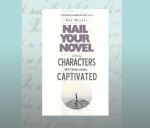 Dave has recently been developing a sitcom, which has led to interesting conversations about the characteristics of the form. To get a feel for it, we have been watching Seinfeld – and especially the season where they write a TV show ‘about nothing’.
Dave has recently been developing a sitcom, which has led to interesting conversations about the characteristics of the form. To get a feel for it, we have been watching Seinfeld – and especially the season where they write a TV show ‘about nothing’.
At the risk of sounding precious, this phrase ‘A show about nothing’ seems to be the key to the entire sitcom form. Not just Seinfeld, but sitcoms generally. And more widely – which is why I’m bothering you with it here – I think some of its principles could be used to make all fictional characters a little more lifelike.

So – in a sitcom we generally watch characters in everyday life, doing their thing. There aren’t any big changes in the status quo (and if there are any coming in Seinfeld, please don’t tell me as we’re only on Season 4). The pleasure and entertainment comes from watching the characters deal with endless small stories and challenges, which are mainly caused by their personalities. (Yes, even in Red Dwarf.) It’s essential that the characters become pretty exasperated with each other, but only up to a point – no matter what happens, they continue to rub along together.
The mad neighbour Kramer isn’t going to move to a different block (or if he is, he’ll be back by the end of the episode). George louses up the TV deal with NBC with some agonisingly inept negotiating, but Jerry continues to work and hang out with him.
Equilibrium of irritation
In Seinfeld, as in most sitcoms, an abiding principle is that life goes on, relationships go on (think of the 1970s BBC sitcoms like The Good Life). Sitcoms are about people being themselves and accommodating each other in an equilibrium of irritation.

Of course, certain characteristics are exaggerated for comedy, but even so, the sitcom is very true to life, and it struck me that we can use the ‘equilibrium of irritation’ to add richness to characters in a story that has a bigger dramatic arc.
Obviously your main characters will go through a big change, but there will be other aspects of life in the story that don’t. These are sometimes underdeveloped – usually because we’ve been looking at the big picture. But instead, they could cause strife that is colourful, charming, exasperating and human. This could give plausible complexity to characters, and depth to the ordinary grift of their lives.
Again, Seinfeld is deliberately amplified for comedy – the neighbour is madder than most neighbours the rest of us have. George is a walking disaster. Seinfeld world isn’t intended to be 100% realistic. But there’s one aspect that I find very realistic – the way the characters rub along day to day.
The magazine episode
Here’s an example. On a magazine I worked on, I had a boss who I’ll call Jim. Jim was often alarmed at my zeal for rewriting articles to make them zap. He warned me gently that if I did that, the reporters might become slapdash because they knew I’d do a final polish.
I’d get in a huff, saying ‘I can’t leave the article in that state – look at all that dull repetition’.
Jim would say: ‘Just skim it to check it’s usable. We have a 120-page issue to get out, we don’t have time for fine editing and we need to leave the writing to the reporters’.
Fuming cloud over Roz’s head.
Jim’s other sub-editor, who I’ll call Wendy, had worked there for 10 years, knew all the routines, and worked according to Jim’s system. She skimmed the copy for obvious bloopers but didn’t wield the scalpel. But Wendy sometimes missed important mistakes and indeed Jim would often be exasperated at this.
And here we have the Sitcom of Jim. Life would never run smoothly. It had these two opposite characters, who created low-level strife on a weekly basis, and who he probably beefed about to his friends – Roz who was going to upset the system and make the well-trained reporters think they could hand in rougher copy. And Wendy who knew all the systems but was slow and unreliable. And Jim just had to get along with us as well as he could.
The Sitcom of Jim had no arc or end. It was a set of personalities and values that aligned in some ways and clashed in others, and was utterly intrinsic to who we were.

The Sitcom of You
Life is full of dynamics like this, with families, friends, colleagues… All these people in our lives need certain amounts of circumvention and handling. There’s the close friend you can’t tell about your work troubles because they’ll simply tell you to get a different job. There are the old friends who can’t be invited to dinner with certain others because they irritate the bejesus out of them, or have politically incompatible views even though you love them dearly, or whose dietary preferences are too bizarrely restrictive to inflict on anyone else. (I note there’s a Seinfeld episode called The Dinner Party but I haven’t seen it yet – no spoilers, please.)

We are all playing the balancing acts of sitcoms in many areas of our lives, and these relationships will keep ticking along in the same constant way. This push-pull accommodation is the stuff of life. And in books, it’s often missing, especially with supporting characters – and so relationships might read as bland and undercooked.
The truth
Of course, you have to tailor this kind of material to fit with the tone. I’m not suggesting you add comedy willy-nilly, or deluge the reader with distracting trivialities. You may only need a very small amount of this kind of material. Indeed you might just keep it as developmental notes that let you write the characters with more knowledge, and keep it 90% under cover. Adjust to taste and the needs of your genre.
But this kind of material can create characters that live and breathe on their own, with independent life – instead of plot zombies.
And you never know – as with all developmental work, the sitcom jottings might blossom into something significant.
Thanks for the Seinfeld apartment pic Tony Hoffarth on Flickr
 There’s a lot more about character development in the Nail Your Novel characters book.
There’s a lot more about character development in the Nail Your Novel characters book.
And if you’re curious about what’s going on at my own writing desk, find my latest newsletter here and subscribe to future updates here.




